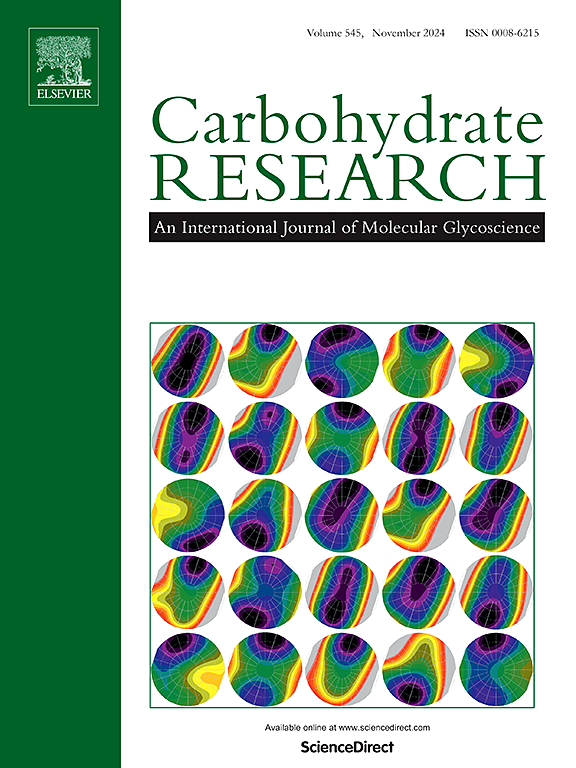4(6)-β-d-葡萄糖吡喃氨基-2- r -1,3-苯并噻唑的合成、结构和抗病毒活性
IF 2.5
3区 化学
Q3 BIOCHEMISTRY & MOLECULAR BIOLOGY
引用次数: 0
摘要
利用无保护的d-葡萄糖在乙醇溶液中对氨基-2-五氟磺胺-1,3-苯并噻唑和氨基-2-三氟甲基-1,3-苯并噻唑衍生物进行糖基化,一步立体选择性合成了β- n -苯并噻唑糖苷。用x射线晶体学证实了β- n -糖苷的结构。在NH4Cl/H2O介质中,以相应的硝基衍生物为原料,用铁还原法制备了含五氟磺胺基和三氟甲基的4-和6-氨基取代苯并噻唑。采用电位酸碱滴定法测定了新型氨基苯并噻唑的pKa值。测定了新化合物在MDCK和Wish细胞培养中的细胞毒性,以评价其生物活性,并研究了其对甲型H1N1流感病毒的抗病毒活性。结果表明,4-β-d-glucopyranosylamino-2-(三氟甲基)-1,3-苯并噻唑具有抑制病毒在细胞内繁殖的能力。本文章由计算机程序翻译,如有差异,请以英文原文为准。

Synthesis, structure, and antiviral activity 4(6)-β-d-glucopyranosylamino-2-R-1,3-benzothiazoles
A one-step stereoselective synthesis of β-N-benzothiazolyl glycosides was developed by glycosylation of amino-2-pentafluorosulfanyl-1,3-benzothiazole and amino-2-trifluoromethyl-1,3-benzothiazole derivatives using unprotected d-glucose in ethanol solution. The structure of β-N-glycosides was confirmed by X-ray crystallography. Starting 4- and 6-amino substituted benzothiazoles bearing pentafluorosufanyl and trifluoromethyl groups were prepared from the corresponding nitro derivatives by the reduction with iron in NH4Cl/H2O media. The pKa values of the new aminobenzothiazoles were determined by potentiometric acid-base titration. Cytotoxicity in MDCK and Wish cell cultures was determined to evaluate the biological activity of the new compounds, and the antiviral activity against influenza virus type A (H1N1) was investigated. It was shown that 4-β-d-glucopyranosylamino-2-(trifluoromethyl)-1,3-benzothiazole shoved the ability to inhibit virus reproduction in cells.
求助全文
通过发布文献求助,成功后即可免费获取论文全文。
去求助
来源期刊

Carbohydrate Research
化学-生化与分子生物学
CiteScore
5.00
自引率
3.20%
发文量
183
审稿时长
3.6 weeks
期刊介绍:
Carbohydrate Research publishes reports of original research in the following areas of carbohydrate science: action of enzymes, analytical chemistry, biochemistry (biosynthesis, degradation, structural and functional biochemistry, conformation, molecular recognition, enzyme mechanisms, carbohydrate-processing enzymes, including glycosidases and glycosyltransferases), chemical synthesis, isolation of natural products, physicochemical studies, reactions and their mechanisms, the study of structures and stereochemistry, and technological aspects.
Papers on polysaccharides should have a "molecular" component; that is a paper on new or modified polysaccharides should include structural information and characterization in addition to the usual studies of rheological properties and the like. A paper on a new, naturally occurring polysaccharide should include structural information, defining monosaccharide components and linkage sequence.
Papers devoted wholly or partly to X-ray crystallographic studies, or to computational aspects (molecular mechanics or molecular orbital calculations, simulations via molecular dynamics), will be considered if they meet certain criteria. For computational papers the requirements are that the methods used be specified in sufficient detail to permit replication of the results, and that the conclusions be shown to have relevance to experimental observations - the authors'' own data or data from the literature. Specific directions for the presentation of X-ray data are given below under Results and "discussion".
 求助内容:
求助内容: 应助结果提醒方式:
应助结果提醒方式:


